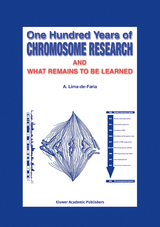One Hundred Years of Chromosome Research and What Remains to be Learned
Springer-Verlag New York Inc.
978-1-4020-1439-0 (ISBN)
Emphasis is placed on what remains to be learned, particularly in light of reality of the sequencing of DNA which leaves the previous era of chromosome research as a prehistoric event. It is at this turning point, that well formulated questions can be asked about many of the chromosome's properties, which remain to be unveiled.
The author, Lima-de-Faria is Professor Emeritus of Molecular Cytogenetics at Lund Unviersity, Sweden, previously Head of the Institute of Molecular Cytogenetics, Lund University.
First Period 1795–1850 The precursors: Better microscopes allowed reaching the cell level.- Second Period 1850–1900 The pioneers: The discovery of the chromosome was a by-product of microbiology.- Third Period 1900–1930 The era of abstract genetics: Order in embryonic development led to the finding of order in inheritance.- Fourth Period 1930–1950 The impact of physics and chemistry on genetics: World War II encouraged the development of microbial genetics.- Fifth Period 1950–1970 Radioisotopes and electron microscopy became a most fruitful combination: Molecular biology received its main impulse from disciplines outside genetics.- Sixth Period 1970–1980 The mechanisms of cancer and of development were sought at the DNA level: Biotechnology emerged as a new field as genetics created its own weapons.- Seventh Period 1980–1990 Neurobiology reached the molecular level: Artificial chromosomes and gene therapy became a reality.- Eighth Period 1990–2001 The genome of humans and of other organisms was sequenced: The age of multilaboratory collaboration was established.- Ninth Period 2001–2010 The post-genome era: The task that lies ahead.- From staining methods to DNA sequencing.- Main stages in the discovery of the cell’s structure and function.- The nucleus versus the cytoplasm. Which was most important?.- The description of cell division: An impressive transformation was accompanied by directed cellular movements.- Meiosis was another unexpected property: The cell could reduce its chromosome number.- The maintenance of identity of the chromosome during interphase was accompanied by constancy and variability of pattern in different tissues.- The centromere: A Pandora’s box of unearthed properties.- The telomere: Not just a terminus station.- Thenucleolus organizer: Nothing in the cell is comparable to it.- Cytoskeleton: A disgusting artifact became an important cell edifice.- Nuclear envelope: The nucleus disclosed its outer structure.- Centriole: An enigmatic cell invention.- Endoplasmic reticulum and Golgi apparatus: The building of membranes permitted molecular reactions to occur in defined sequences.- Cell membrane and cell wall: The cell became an individualized entity.- Chromosomes of viruses: An early or a late form of chromosome?.- Chromosomes of bacteria: Nearly naked DNA could become independent.- Chromosomes of mitochondria: Intruders invaded the cell.- Chromosomes of chloroplasts: Additional genomes entered the cell.- Physico-chemical processes are antithetical.- Maintenance of organization: The protozoan versus the human chromosome.- Maintenance of the chromosome phenotype.- Maintenance of gene order.- Maintenance of function.- The periodicity of chromosome transformations.- Structural change.- Change of pattern.- Change in size.- Change in number.- Change in function.- The models.- What the models do not tell us.- Where did the chromosome come from?.- Where is the chromosome going?.- Bibliography: A list of selected books that have dealt with the chromosome during the period 1870–2001.- References: Cited works between 1990 and 2001.- Sources of Illustrations 195—.- Subject inde.- Author inded.
| Zusatzinfo | 549 Illustrations, black and white; VII, 219 p. 549 illus. |
|---|---|
| Verlagsort | New York, NY |
| Sprache | englisch |
| Maße | 210 x 297 mm |
| Themenwelt | Naturwissenschaften ► Biologie ► Genetik / Molekularbiologie |
| Naturwissenschaften ► Biologie ► Mikrobiologie / Immunologie | |
| ISBN-10 | 1-4020-1439-2 / 1402014392 |
| ISBN-13 | 978-1-4020-1439-0 / 9781402014390 |
| Zustand | Neuware |
| Haben Sie eine Frage zum Produkt? |
aus dem Bereich




